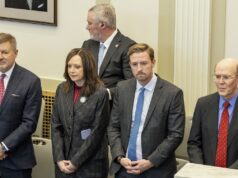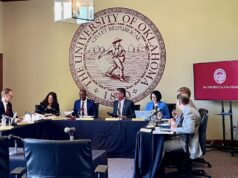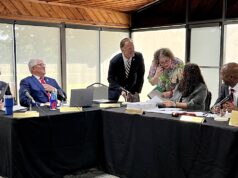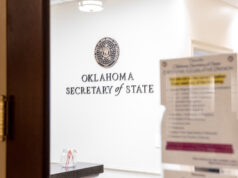Surrounded by local leaders and seated across from Mayor Larry Heikkila, University of Oklahoma President Joe Harroz led a press conference today hyping OU’s long-desired new Norman arena and entertainment district proposal that would receive about 20 percent of its funding from a Tax Increment Finance district that faces a Planning Commission vote June 13 and final City Council consideration sometime later this summer.
To hear more about the new Norman arena proposal that has faced criticism for years owing to a lack of concrete details, media packed into an Evans Hall conference room adorned with European art, proclamations promoting NCAA championships and a pair of project renderings perched upon easels.
In six minutes of opening remarks, Harroz called the potentially $1 billion project “stunning” and claimed it would add thousands of housing options and 5,000 new jobs to Norman. A similar proposal was withdrawn from a City Council agenda in 2018 to avoid an anticipated rejection of the requested TIF district, but the project has regained steam as OU transitions to the Southeastern Conference for athletics.
“This is thought through completely. This is thought through with a great deal of effort. (…) This is what progress looks like,” Harroz said. “The diligence has been done. The time, the effort, the work, the crunching of numbers — 70, 80, 90 iterations of different documents to make sure they are as honed as they can be. Now it’s time for all of that work to go to the vote. To go to the final votes.”
But with all eyes on municipal consideration of the proposed TIF district — which would retain property and sales tax dollars to fund about $230 million of the roughly $300 million multipurpose arena — other uncertainties about the project remain, namely: What will OU contribute financially, and who will own the arena once it is built?
Posed those questions during Wednesday’s press conference, the assembled executives offered partial answers. Harroz said OU’s two basketball programs and two gymnastics teams would combine to account for 24 percent of the new Norman arena’s day-to-day occupancy.
“Our primary contribution to this will be to pay rent in the arena component,” Harroz said.
Asked what those rental estimates look like — the university owns and operates the teams’ current home at Lloyd Nobel Center — OU Athletic Director Joe Castiglione attempted to summarize the financial plan as an up-front investment combined with annual operational dollars paid over a 25-year period.
“Let me just put it this way: We know initially there’ll be $25 million put in, and another $75 million — that’s a combination of rent and operations — going to the bottom line of the arena itself,” Castiglione said. “So you can count on, from an athletics standpoint, over $100 million toward it.”
OU officials quickly said they would like to clarify and elaborate upon Castiglione’s financial remarks, although no additional information was provided until about 8:30 p.m.
“Today in his comments, developer Danny Lovell cited an approximate arena project cost of $330 million. Of that, $298 million is the arena’s construction and more than $30 million will go toward infrastructure, funded by the TIF,” Jen Hollingshead, OU vice president of marketing and communications, said in a statement. “Tentative financial modeling has the university funding between 26 and 28 percent of the performance venue’s development, which has an expected total project cost of $298 million. Of that, approximately $25 million will be upfront private capital from the university. Those initial contributions from OU do not include anticipated annual rental fees that are still being determined.”
The term “private capital” likely applies to fundraising or investment dollars earned by the OU Foundation, which took over all fundraising operations for the university in 2021. The OU Foundation owns the University North Park property slated for the entire development proposal, which involves the arena, office space, high-density apartments and medium-density housing to be built by The Rainier Companies. The land was historically part of a World War II-era U.S. Naval Base dubbed “north base” in Norman lore.
“We’re making the land available for both the private part of the development as well as the development of the arena,” OU Foundation President Guy Patton said Wednesday. “I think it’s not exactly clear yet who will own and operate the arena once constructed. There’s a couple of options that will be driven by financing and the best structure to get the best rate for financing.”
Asked for details, Patton described “two big options” for the arena’s ultimate ownership.
“It could be privately owned. It could be publicly owned through a public trust,” Patton said. “And if it’s privately owned, there are a bunch of options within that, which would include the foundation playing a role. But it all comes down to what’s the best strategy for financing and construction.”
Asked his preference as mayor of Norman, Heikkila said he does not think the city should take on the task.
“I would prefer to see a public trust, and that’s just my opinion. It’s got nothing to do with the way I want to drive (it),” Heikkila said. “I would prefer to see a public trust own that or the university own that. We’re just not in the management business of those types of things. Roads? Sewers? Yes.”
What is a TIF?
When creating a Tax Increment Financing district, cities designate anticipated increases in future sales tax and/or property tax revenues as collateral to borrow money for investment into development.
TIFs can last up to 25 years, and the loans are ultimately repaid by the increased tax payments from the redeveloped areas.
The lingering unknowns regarding the proposal have left some Norman residents and elected officials feeling uncertain themselves.
“The press release was rather vague and didn’t include any actual details,” Ward 7 Councilman Stephen Tyler Holman said Wednesday afternoon. “A lot of claims were made about jobs and housing, but I have yet to see any data or plans that support those numbers. I look forward to them sharing those details.”
Still, Visit Norman executive director Dan Schemm said during Wednesday’s press conference that “we’re at a seminal moment in Norman’s history.”
“This is an opportunity for us to invest in ourselves. We’re the third-largest city in the state, and it’s time we start acting like it,” Schemm said. “Let’s make the same investments that our neighbors are doing. We see other communities around us investing a billion dollars into new arenas. We see luxury RV parks and other things being built. It’s time for us to act like the third-largest city and make those same types of investments.”
It was unclear whether Schemm’s comment about “luxury RV parks” was made in reference to an announced project on the southern border of Norman at Classen Boulevard and Post Oak Road, or whether he was referencing the controversial proposal for a massive RV Park in Vinita.
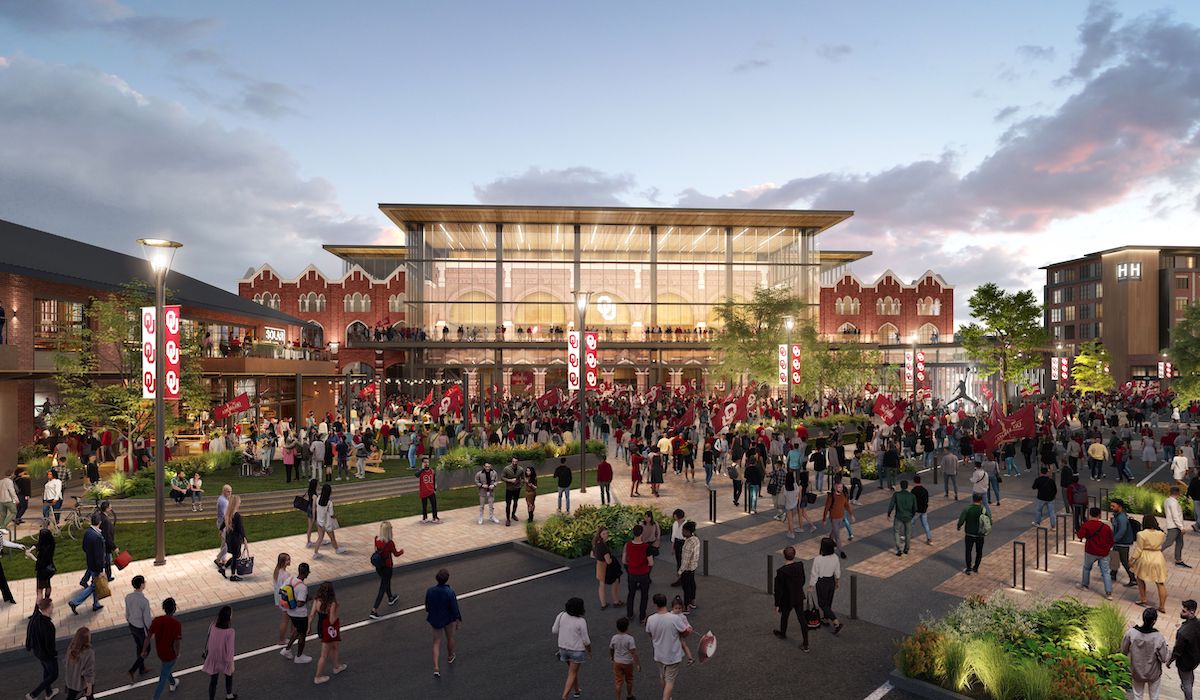
Meanwhile, Griffin hospital property remains in limbo
What Norman may or may not do with the proposed TIF district, arena and associated developments will be front of mind for Norman residents until a potential City Council vote sometime late this summer.
But another major development question also remains unanswered for Norman leaders: What will happen with the roughly 700 acres of land owned by the state as Griffin Memorial Hospital?
“I am really wanting to get that question settled,” Heikkila said after Wednesday’s event. “We’re spending the tax money that’s [from] the arena, so that doesn’t help us in this area.”
For years, state and Norman leaders have discussed the city buying the Griffin property for development of residential, commercial and even social-service facilities, such as a lingering proposal for a permanent homeless shelter.
“I don’t like the idea of a permanent shelter just as a base question. Will I get forced into it? Probably,” Heikkila said. “My thing is that I don’t think the city has any mandate to do social programs. That’s a county health (department) and a state health (department) kind of deal. Where does that come into reality? You know, I can like or not like whatever I want. Will I be forced to do that? Could be.”
While the Oklahoma Department of Mental Health and Substance Abuse Services has hoped to net a $50 million sales price — an amount expected to serve as a key funding component for the agency’s new mental health hospital in Oklahoma City — conversations have stalled, much to the irritation of state legislators and city officials.
“We’re trying to talk to them because what we’re trying to do is get a good deal for both sides,” Heikkila said. “We just haven’t been able to communicate yet. I don’t understand why. I’d like to make that deal, but I haven’t been able to.”
Heikkila said he has not been able to secure a meeting with ODMHSAS officials all year, despite their recent presentation to a state legislative committee about the Griffin property.
“I bet it’s been six or nine months,” Heikkila said.
Among other complicating factors for the property is that some of its abandoned buildings will likely be expensive to tear down owing to asbestos and other issues.
“What are we going to do with those buildings? We can’t just pick them up and move them,” Heikkila said. “The amount of money that is going to go into abatement (…) is part of the question.”
Heikkila said he would like to have the state sell the Griffin property for local development, and he said he would like the area to be designated as a TIF itself.
“I’ve got to protect those ball fields. That’s the big thing. I would really like to have the property south of Robinson (Street) and north of Main (Street) and use that to develop another enterprise area where we have entertainment and other kinds of things — revitalize downtown,” Heikkila said. “Part of that is the homeless question. How do we do that? How do we fit that in? We are a very factionalized society here in Norman and probably all over. I’m not going to be able to please everybody. It’s just what arrows do I want to take today?”
(Update: This article was updated at 9:35 p.m. Wednesday, June 5, to include a statement from Hollingshead and to adjust numbers from what was stated at the press conference to the numbers provided in the statement.)











